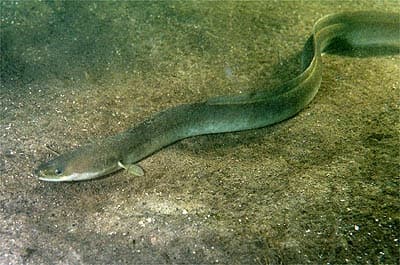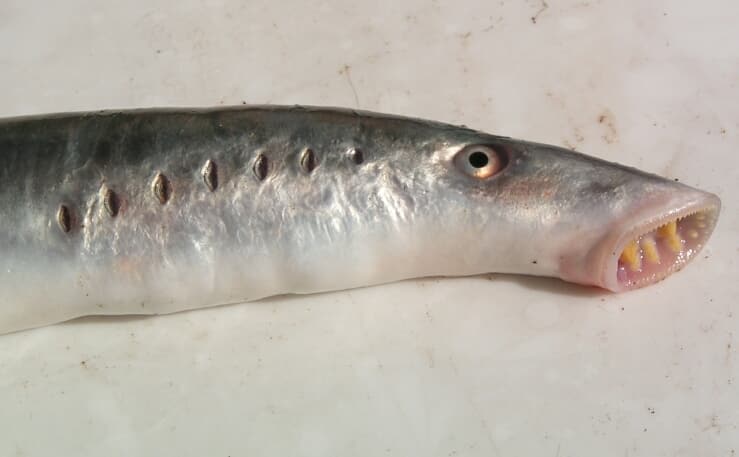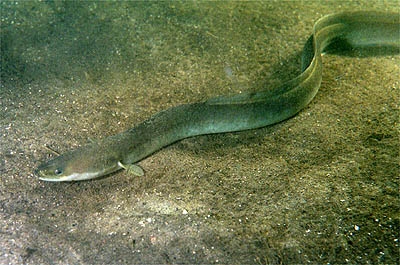Eel vs Lamprey: A Complete Comparison
Despite their serpentine similarities, eels and lampreys represent two fundamentally different groups of aquatic animals. While eels are true fish with jaws and paired fins, lampreys belong to an ancient lineage of jawless vertebrates that emerged over 360 million years ago. The European eel (Anguilla anguilla) typically reaches lengths of 1.5 feet (0.5 meters), while the sea lamprey (Petromyzon marinus) can grow up to 3 feet (0.9 meters) long.
These remarkable creatures have evolved similar body shapes through convergent evolution, but their internal anatomy, feeding mechanisms, and life cycles reveal stark contrasts. Let’s dive deep into the fascinating world of eels versus lampreys to understand what makes each unique.

© GerardM / CC BY-SA 3.0
The European eel showcases the classic features that distinguish true eels from lampreys: a defined jaw, paired pectoral fins, and the characteristic pointed snout that houses a complex sensory system.

© Tiit Hunt / CC BY-SA 3.0
The Pacific lamprey demonstrates the distinctive features of its ancient lineage, including the circular suction-disc mouth and the row of seven gill openings along each side of its body.
Key Differences Between Eels and Lampreys
| Feature | Eel | Lamprey |
|---|---|---|
| Mouth Structure | Hinged jaw with sharp teeth | Round suction disc with rasping teeth |
| Breathing | Single pair of gill slits | 7 pairs of gill openings |
| Skeleton | Bony skeleton | Cartilaginous skeleton |
| Fins | Paired pectoral fins present | No paired fins |
| Size | Up to 4 feet (1.2m) | Up to 3 feet (0.9m) |
| Diet | Predatory: fish, crustaceans | Parasitic or filter feeding |
Anatomical Differences
The most striking difference between eels and lampreys lies in their mouth structure. Eels possess true jaws with sharp teeth designed for catching and gripping prey. In contrast, lampreys have a distinctive circular suction-disc mouth equipped with rasping teeth used either for parasitic feeding or filter feeding, depending on the species.
Habitat and Distribution
While both creatures can be found in marine and freshwater environments, their habitat preferences differ significantly. Most eel species begin life in marine environments and migrate to freshwater, while lampreys typically live in coastal waters and rivers. The European eel makes one of the most remarkable migrations in nature, traveling up to 3,700 miles (6,000 kilometers) to spawn in the Sargasso Sea.
Life Cycle Comparison
Eels undergo a complex metamorphosis, transforming from transparent leaf-like larvae (leptocephali) to glass eels, then yellow eels, and finally silver eels. Lampreys experience a different life cycle, spending 3-7 years as filter-feeding larvae (ammocoetes) buried in river sediments before metamorphosing into adult form.
Ecological Role and Conservation
Both groups face significant conservation challenges. The European eel population has declined by over 90% since the 1970s, while many lamprey species face threats from habitat destruction and river barriers. Despite their parasitic reputation, lampreys play crucial roles in marine ecosystems as both predator and prey.
Who Would Win in a Confrontation?
While direct confrontations between eels and lampreys are rare in nature, eels generally have the advantage in terms of defensive and offensive capabilities. Their powerful jaws, superior maneuverability, and more robust muscular structure make them better equipped for predatory encounters. However, both animals typically avoid direct conflict, occupying different ecological niches.
Frequently Asked Questions
Are lampreys actually eels?
No, lampreys are not eels. Despite their similar appearance, they belong to an ancient group of jawless fish called cyclostomes, while eels are true bony fish with jaws.
Which is more dangerous to humans?
Neither animal poses a significant threat to humans. While sea lampreys are parasitic, they rarely attach to humans, and eels generally avoid human contact entirely.
Can you eat both eels and lampreys?
Yes, both animals have been historically consumed by humans. Eels remain a delicacy in many cultures, while lamprey pie was once a royal dish in medieval England.
How can you tell an eel from a lamprey?
The easiest way to distinguish between them is by looking at the mouth: eels have a typical fish-like mouth with a jaw, while lampreys have a distinctive circular suction-disc mouth.











